Masks appear in various forms throughout the world, including Asia, Europe, America, Africa, and Oceania.
However, the Near East region (including Arabia, Northeast Africa, Balkan, and the regions of North Africa under Muslim influences) do not use masks due to religious reasons.
Introduction of World Masks
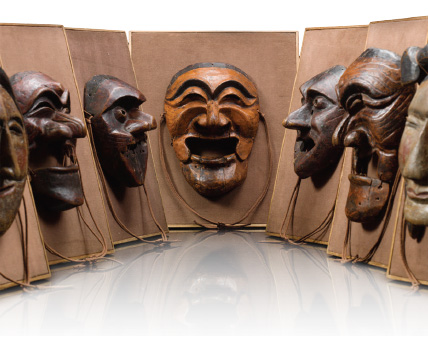
Masks of Korea
Korean masks may be small in size, but they have unique characteristics from each region. The following 13 mask dances from different regions have been designated as important intangible cultural properties and have been passed down from generation to generation; the Bukcheong lion masked play mimicking a magnificent lion waving his head; the Gasan five clowns masquerade characterized by masks made of paper; the Gangneung government office slaves masquerade; the Gosung five clowns and Tongyoung five clowns masked play of Gyeongnam Province; the Dongraeyaryu masquerade of a scary stableman; the Bongsan mask dance and Eunyool mask dance of Hwanghae Province; the Songpa Sandae play originating from Lake Seokchon, a famous masked play of the central region; Sooyoungyaryu performed in a wide field; the Yangju Byeolsandae masked play of Gyeonggi Province, famous for a scene of giving birth to a baby resembling a drunk monk; and the Hahoe Mask Dance Drama of Andong Hahoe Village, a designated world heritage site.
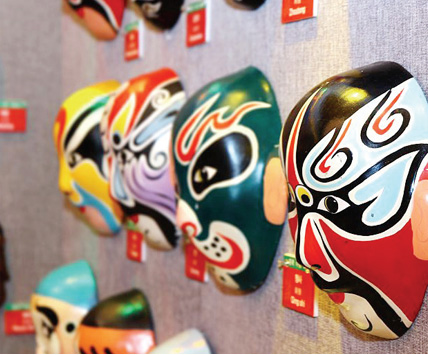
Masks of China
China, which has preserved many cultures in its long history, is a place where masks and mask dances appear in well known stories such as ‘Records of the Three Kingdoms’ and ‘Journey to the West.’ These, among others, have been reborn as Peking Opera, a new genre of masks loved by many. The tradition of heavily painted makeup on a white face commonly seen in Peking Opera was begun to express emotion better than when wearing a traditional mask. The good or evil nature of Chinese masks are often designated by their color, while the number of flags represents the degree of power.
Nahee masks, which have been passed down in the Guizhou Province and Yunnan Province in China, are used to chase demons. When farming became difficult due to drought, when someone in the village was sick, or when an important decision had to be made in the village, it was believed that dancing while wearing these masks could bring you closer to God and get rid of evil demons.
Nahee masks, which have been passed down in the Guizhou Province and Yunnan Province in China, are used to chase demons. When farming became difficult due to drought, when someone in the village was sick, or when an important decision had to be made in the village, it was believed that dancing while wearing these masks could bring you closer to God and get rid of evil demons.

Masks of Asia
Asian masks are deeply tied to faith and customs. For the people in Asia, there existed many Gods such as the Ancestral God, the God of Farming, and the God of Illness from ancient times. Even in a harsh environment, the people relied on the Gods to overcome difficulties. They created the image of the Gods governing each area to worship and use in rituals. Through the masks, the souls of the dead were led to heaven and remembered, illnesses were healed, famine overcame, and harmony achieved. As such, masks have become a part of the traditional culture of each ethnic group in Asia, and are still handed down to this day.
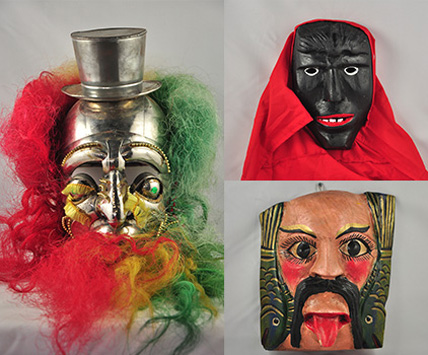
Masks of America
On the American continent, the mastership of masks and festivals in North America versus Central and South Americas is highly contrasting. The culture of the aborigines continued to decline unilaterally through colonization and occupation of Westerners in North America. However, Central and South Americas were not only able to maintain the indigenous culture to some extent, but also to accept the Spanish culture and incorporate it with the indigenous culture in spite of Spanish invasion and colonialism.
For the North American Indians, masks and mask dances are still being passed down in the White Mountain Apache in central Arizona and the tribes of the northwest coast, but masquerades are very rare. In Central and South Americas, the native festivals of aboriginal people and the festivals introduced from colonial Spain co-exist. Many mask dances and festivals are being actively handed down in the present day. In Mexico, Guatemala, and Bolivia, many mask dance groups participate in various festivals. Especially well-known are the tiger dances and the dances of Moors and Christians, the representative festival of Mexico.
For the North American Indians, masks and mask dances are still being passed down in the White Mountain Apache in central Arizona and the tribes of the northwest coast, but masquerades are very rare. In Central and South Americas, the native festivals of aboriginal people and the festivals introduced from colonial Spain co-exist. Many mask dances and festivals are being actively handed down in the present day. In Mexico, Guatemala, and Bolivia, many mask dance groups participate in various festivals. Especially well-known are the tiger dances and the dances of Moors and Christians, the representative festival of Mexico.
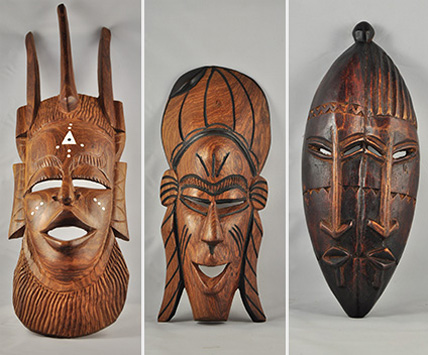
Masks of Africa
African art is closely linked to religion and magic, and plays a functional role in the city, indistinguishable from everyday life. Masks were used in ceremonies praying for abundance, coming of age ceremonies, funerals, ancestral worship, rituals to cure illness, war, inaugurations, and weddings. African art is well-loved worldwide for it’s dynamic, incredible geometric forms and soul-provoking power. African masks are especially stunning and unique. They use the color of wood to represent skin color of the people. The form of the African masks have not only influenced the art of artists like Picasso, Matisse, Brancusi, and Klee, but also provide a source of imagination and inspiration to many.

Masks of Europe
In Europe, masks were used in ancient Greek tragedies. There was a humorous masquerade in Italy called ‘Adelina’ in the first century BC. There was a carnival held just before Catholic Lent in medieval Europe. Carnival was a time set aside to escape the rules and order of everyday life, with the loudest parades, massive masquerades, and satirical theater. There are many festivals such as Nice Carnival in France, the fascinating carnivals of Spain, Venice Carnival and the Battle of the Oranges in Ivrea, Italy, the Cologne Carnival in Germany, and the Carnival of Binche in Belgium.
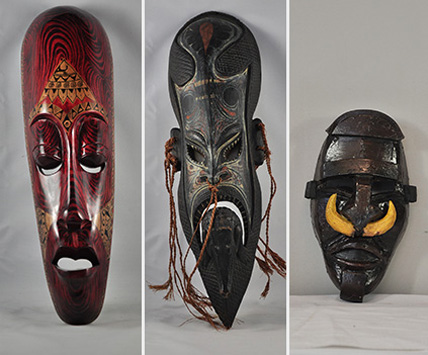
Masks of Oceania
The majority of Oceanic masks are found in Melanesia. Especially in the Safik River region in Papua New Guinea, masks are worn for funerals, coming of age ceremonies, and ritual ceremonies for abundance. There are also decorative masks. Melanesian masks are generally associated with ancestor worship and totem worship. Melanesian masks exaggerate the nose, mouth and head like African masks and are decorated with intense colors and patterns to depict energy.
Function of World Masks
-
01 Varios Rituals and Ceremonies
 Masks are used for abundance, rain, religious ceremonies, funerals, coming of age ceremonies, exorcisms, and memorials.
Masks are used for abundance, rain, religious ceremonies, funerals, coming of age ceremonies, exorcisms, and memorials. -
02 Hunting and War
 Masks are used to strike fear in the hearts of the ememy and also as a means of camouflage.
Masks are used to strike fear in the hearts of the ememy and also as a means of camouflage. -
03 Artistic Purposes
 Masks are used for dance, theater, and decoration.
Masks are used for dance, theater, and decoration.





